Brief

Executive Summary
- The gap between rich and poor has been growing worldwide since the 1980s. Now Covid-19 has further damaged the prospects of lower-income households. This gap will likely widen over the next decade as automation initiatives proliferate across industries, displacing many workers.
- For companies in consumer markets, more affordable pricing and service is just part of the equation, as many segments exist within the huge swath of lower-income consumers. Busy families, for instance, may prize convenience, while other segments seek out discounts or have emotional connections to certain brands.
- Understanding how lower-income consumers perceive value, and being able to deliver that value economically even in turbulent times, is essential for earning their loyalty.
At the lower levels of the income pyramid, there is one obvious certainty: People have less disposable spending power than those at the top. The coronavirus and subsequent business lockdowns damaged the prospects of lower-income households and put stress on many middle-income families as well.
Yet for companies in consumer markets, it would be a mistake to consider low price as the only touchstone for serving lower-income households. People with less income or wealth have needs, desires and priorities as varied as those in other consumer segments.

Macro Surveillance Platform
For more detail on the business implications of coronavirus from Bain’s Macro Trends Group, log on to the Macro Surveillance Platform. Learn more about the platform >
Covid-19 complicates the challenge of connecting with consumers to deliver value at the right price. In recent months, consumers generally have emphasized several Elements of Value℠ from the providers they do business with: reducing risk, reducing anxiety and obtaining a sense of belonging. Alongside those priorities, companies must contend with a longer-term trend of widening income and wealth inequality, which affects access to most aspects of economic life―from food and housing to healthcare, education and digital broadband. The US, for instance, has seen growing lines of people at food banks and pantries, and millions of parents of infants and toddlers who cannot afford diapers. Companies can support customers through these difficult times by developing value propositions that make their lives easier.
The economic crisis caused by the pandemic has exacerbated inequalities. Lockdowns froze entire economies, shutting down formal and informal jobs. The traditional path to prosperity in India, Southeast Asia, Africa and other emerging markets―moving from rural areas to cities―was suddenly no longer an option. According to estimates by the World Bank, national lockdowns and the ensuing economic catastrophe will this year push between 88 million and 115 million people into extreme poverty, defined as subsisting on less than $1.90 per day. That wipes out years of progress. From 1994 until 2019, the number of extremely poor working people (including youths) had fallen from 753 million, or 32% of the world’s working population, to 234 million, or just 7%, according to the International Labour Organization.
Even in developed economies, the downturn that began recently has deepened the division between those who can navigate it and those who can’t. In the US, people with secure jobs, stuck at home with fewer places to spend money and enjoying a rebound in the stock market, have come out unscathed or even ahead, while low- and some middle-income Americans were less prepared financially for the crisis (see Figure 1). Americans in the bottom quintile have been more likely to experience layoffs, to see their hours and pay reduced, and to be forced to draw on savings or take on debt, Gallup surveys show. That pushes many to a financial precipice, even as some evidence indicates that Covid-19 case and death rates run higher in high-poverty areas.
Covid-19 has deepened the income divide in the US
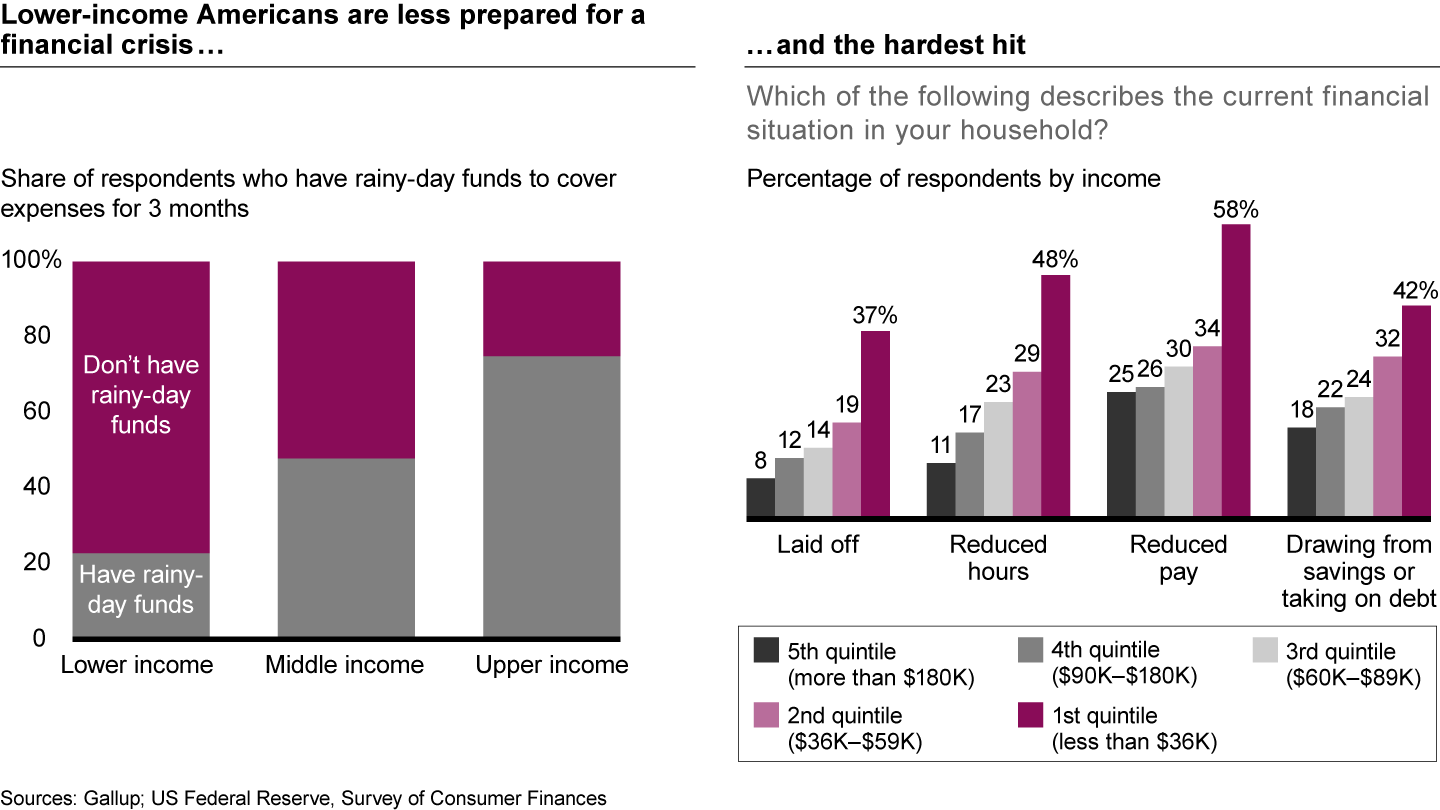
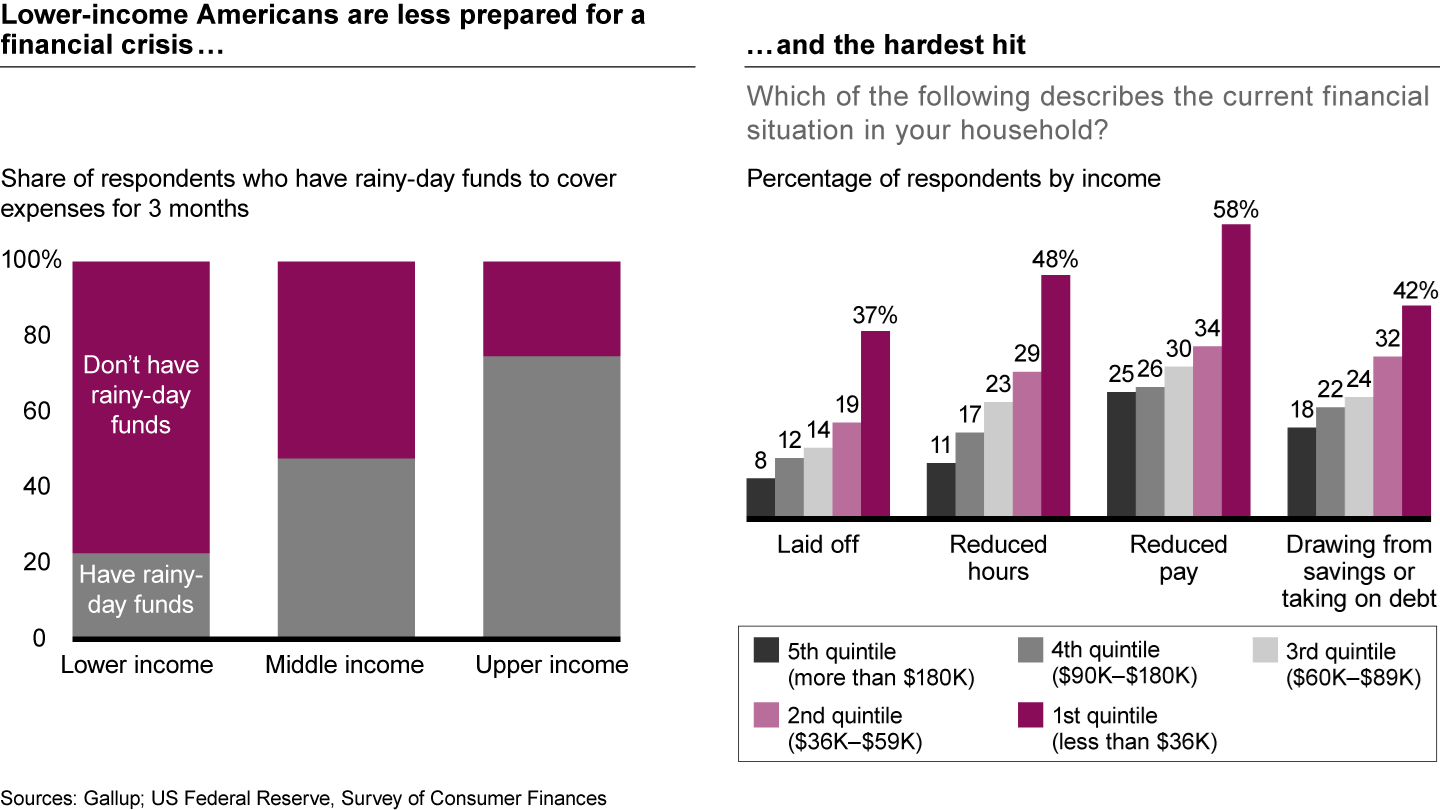
Regardless of when the pandemic abates, or the shape and pace of economic recovery, the widening divide will force companies to realign their propositions to bifurcating markets. They’ll need to deliver different forms of value to an expanding group that has fewer financial resources, or to a smaller group that enjoys even more spending power. In this brief, we focus on how to reach the growing ranks of people toward the bottom of the pyramid.
Inequality’s insidious advance
Consider the long-term trends. The gap between rich and poor people in almost every country, across both developed and emerging markets, has been growing since the 1980s (see Figure 2).
Income inequality has been rising in many countries
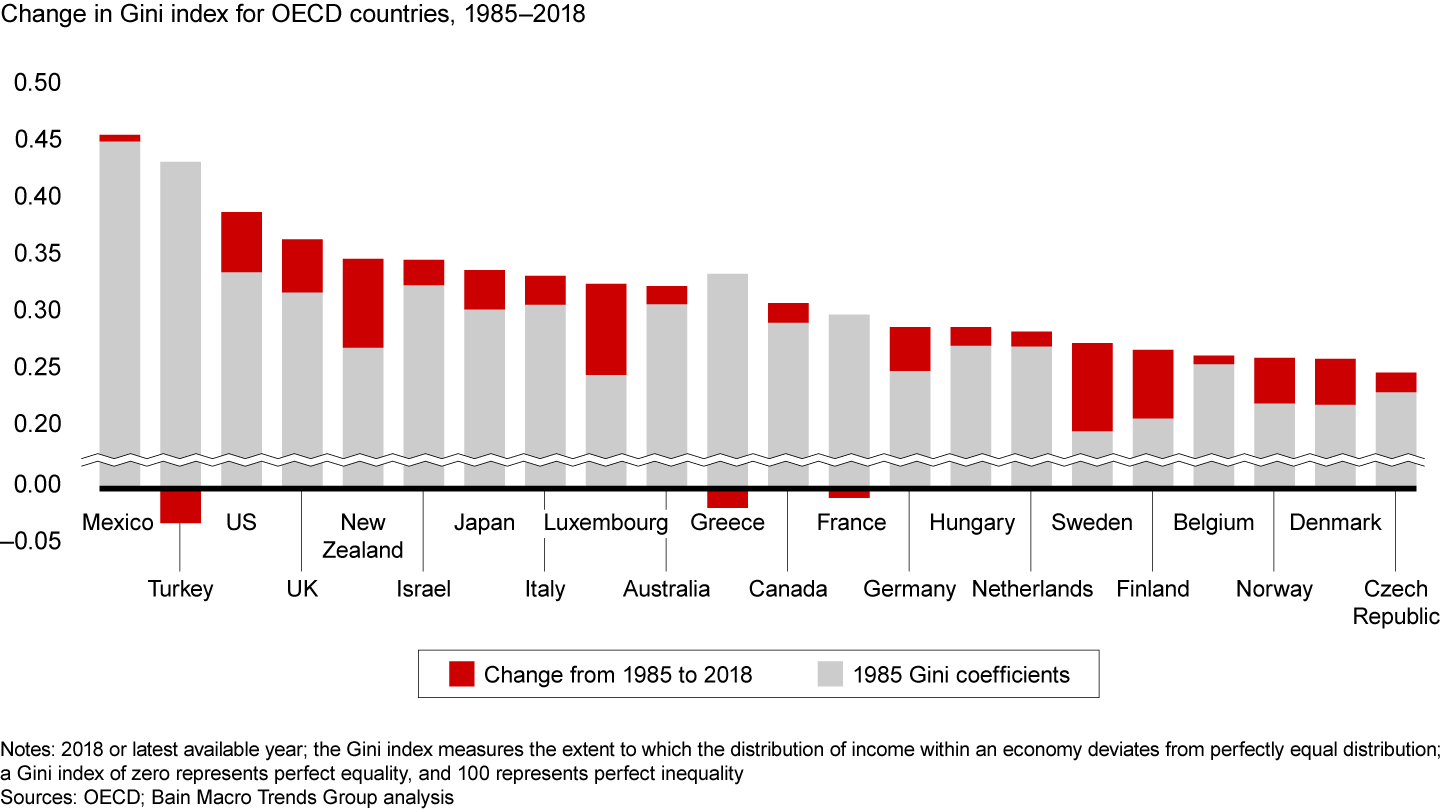
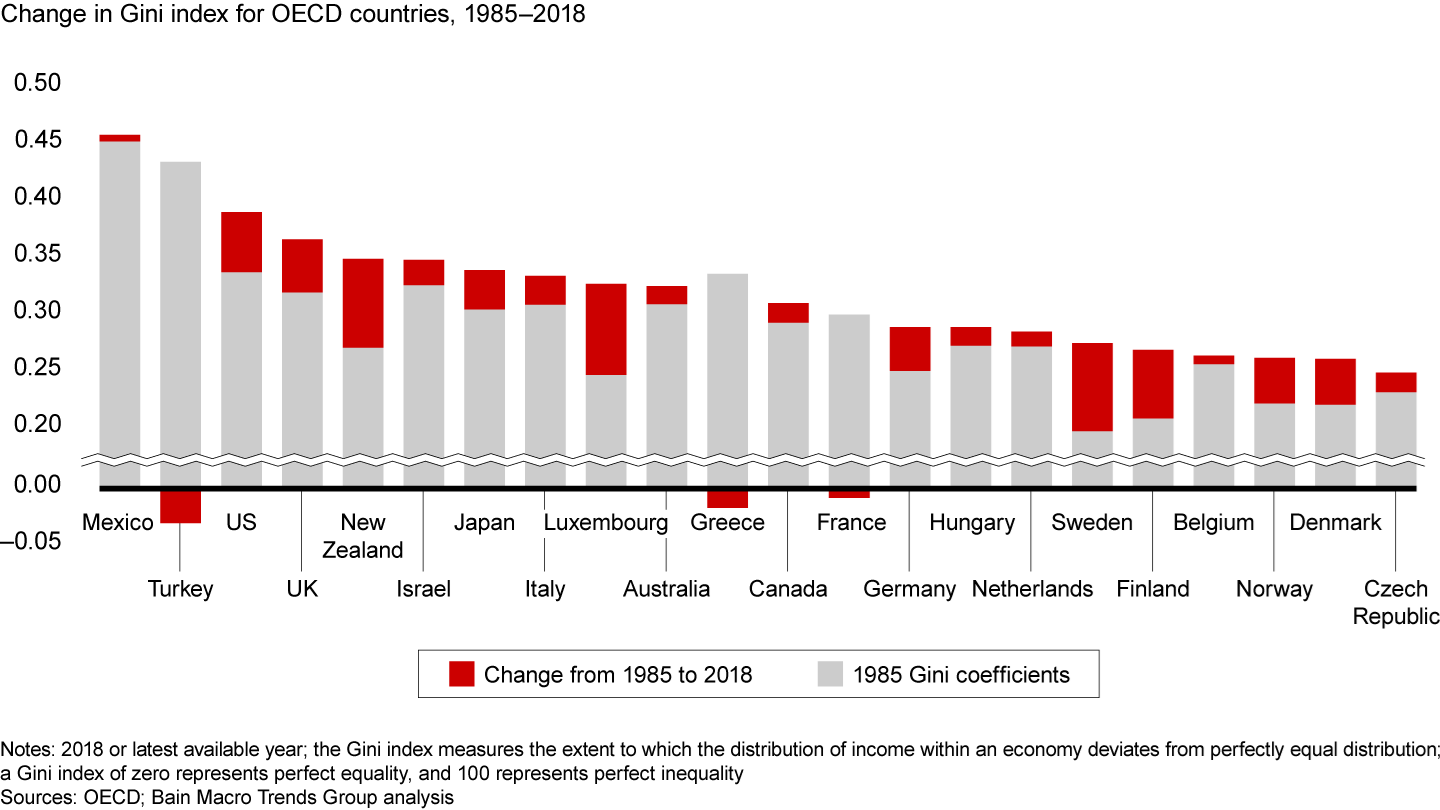
A widening divide is particularly acute in the US, which has a weaker social safety net than other developed economies such as the European Union. Since 1980, upper-income Americans have enjoyed an increasing share of income, wealth and overall spending (see Figure 3).
Inequality has worsened in the US for four decades
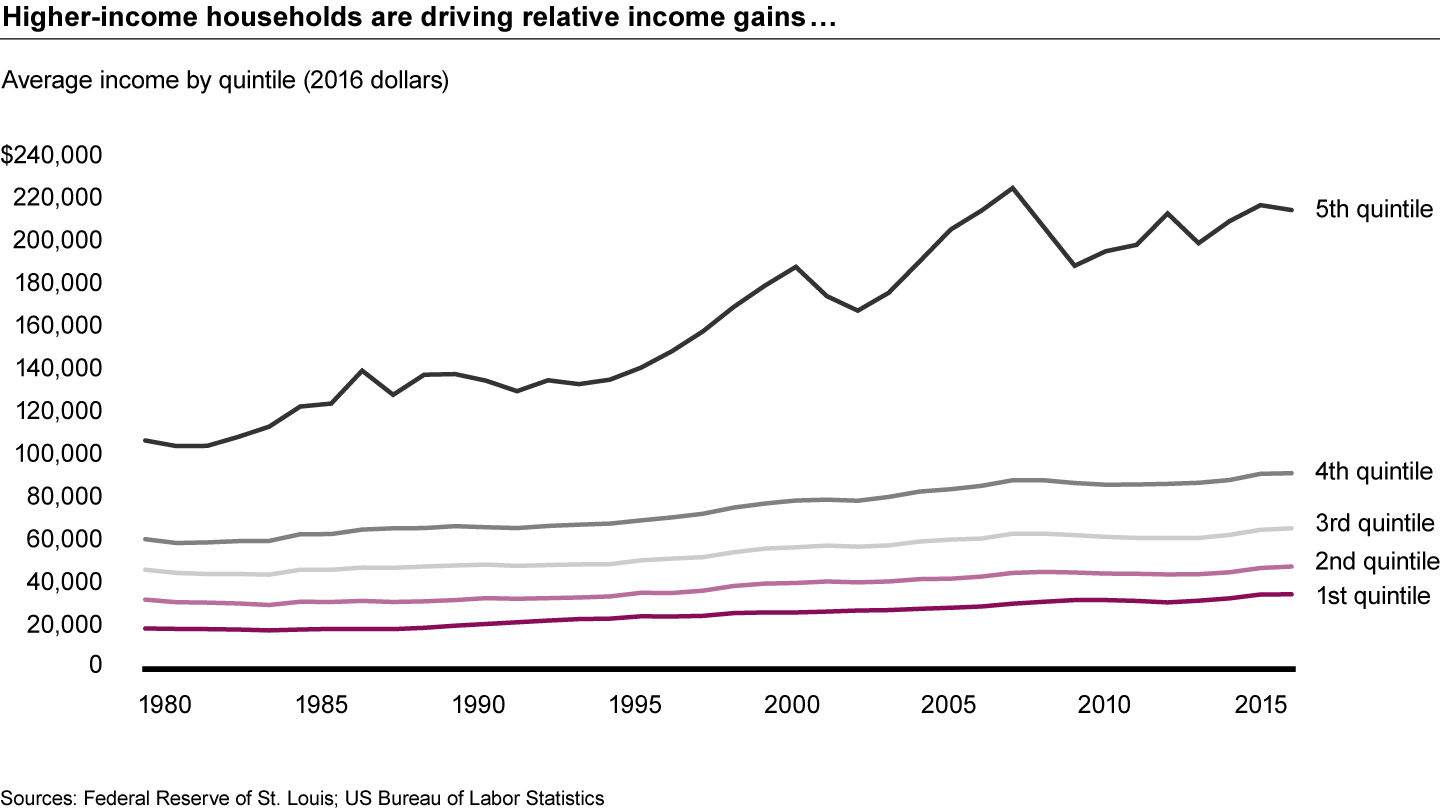
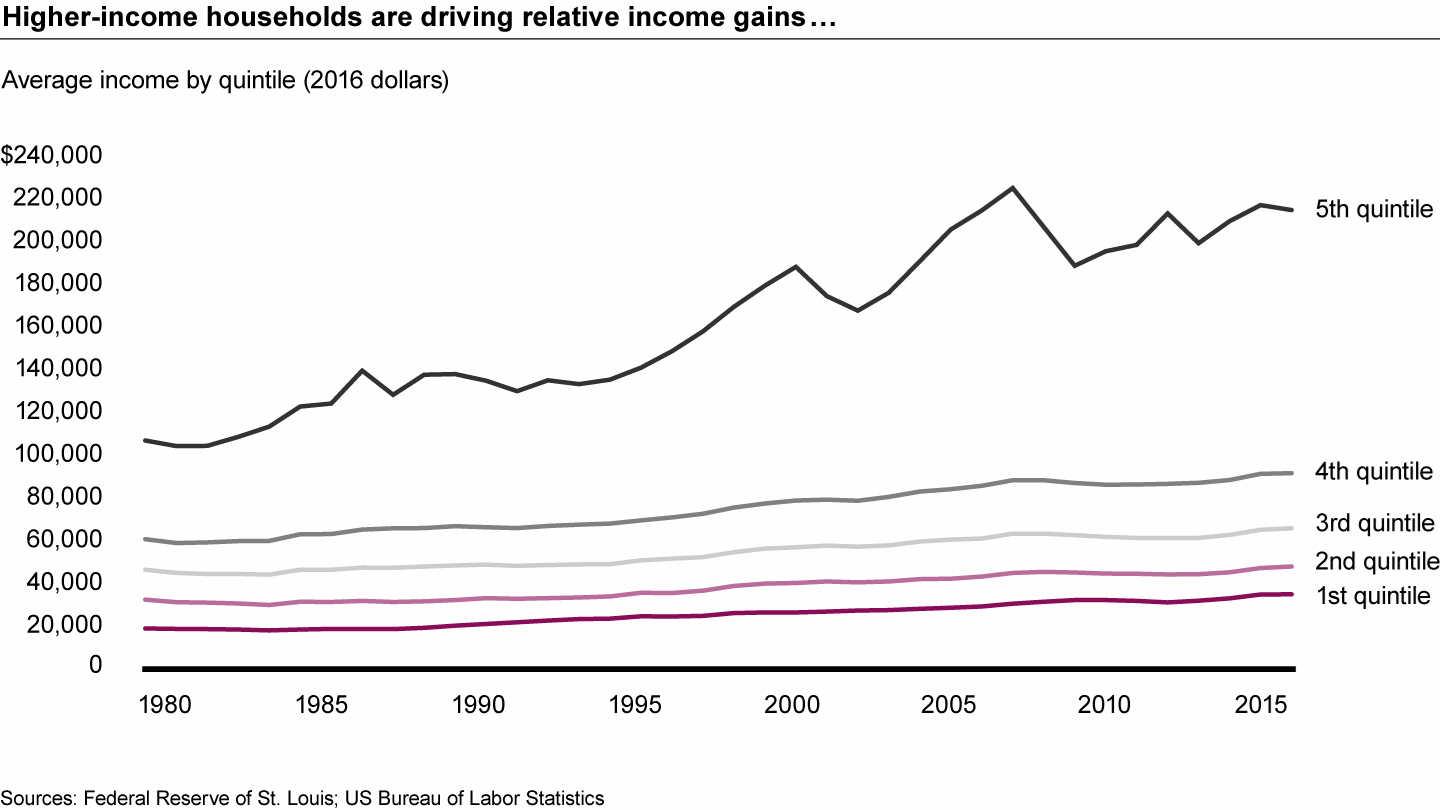
Inequality has worsened in the US for four decades
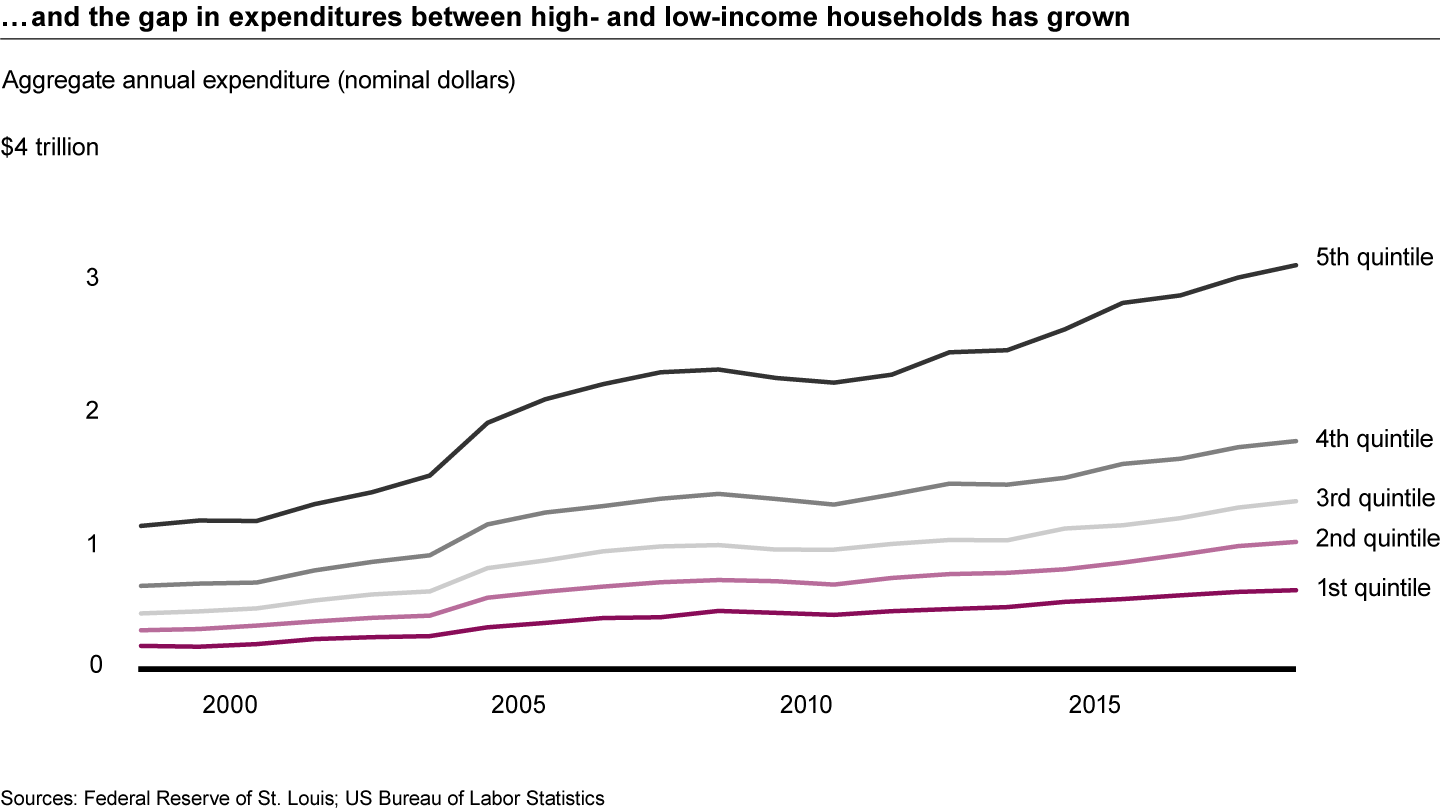
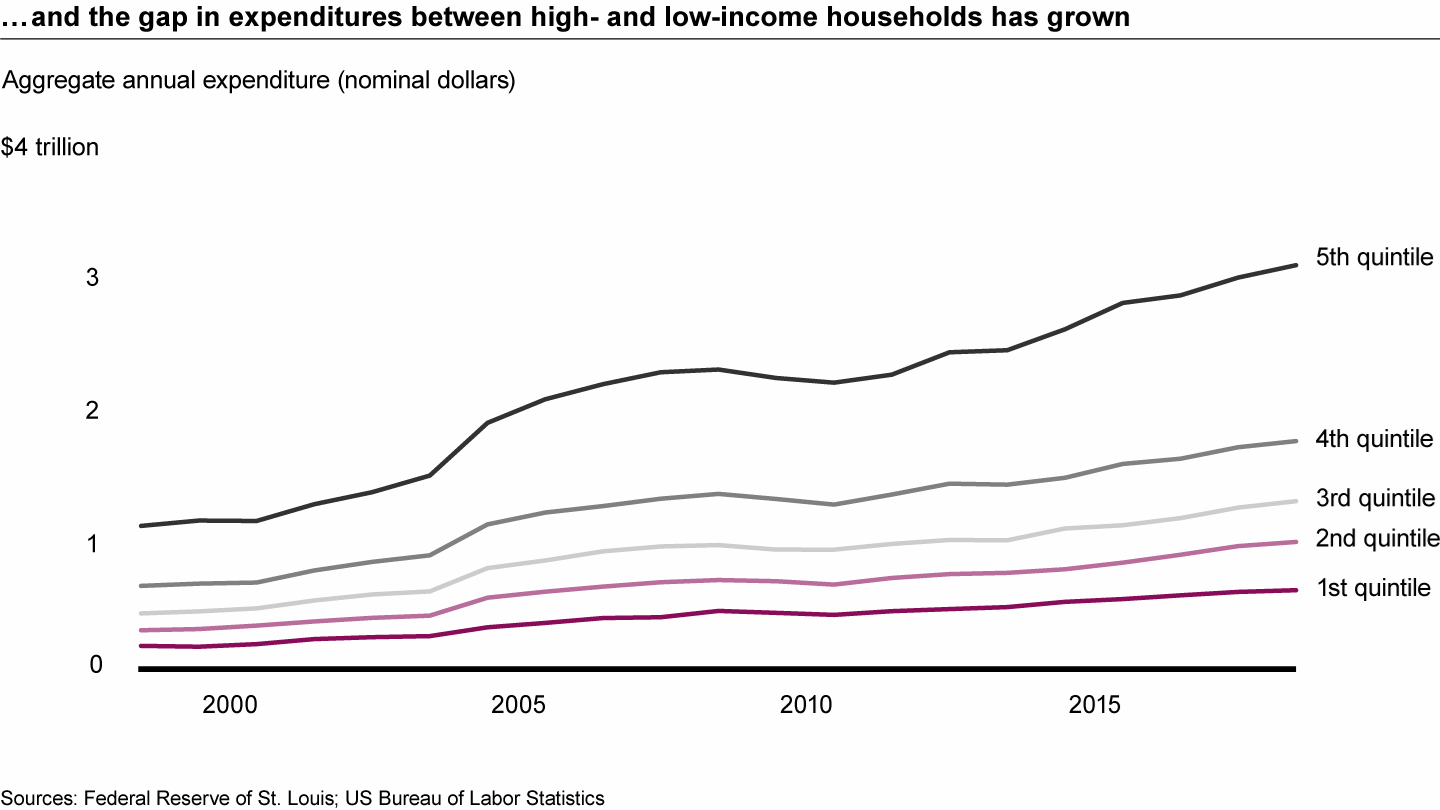
Inequality has worsened in the US for four decades
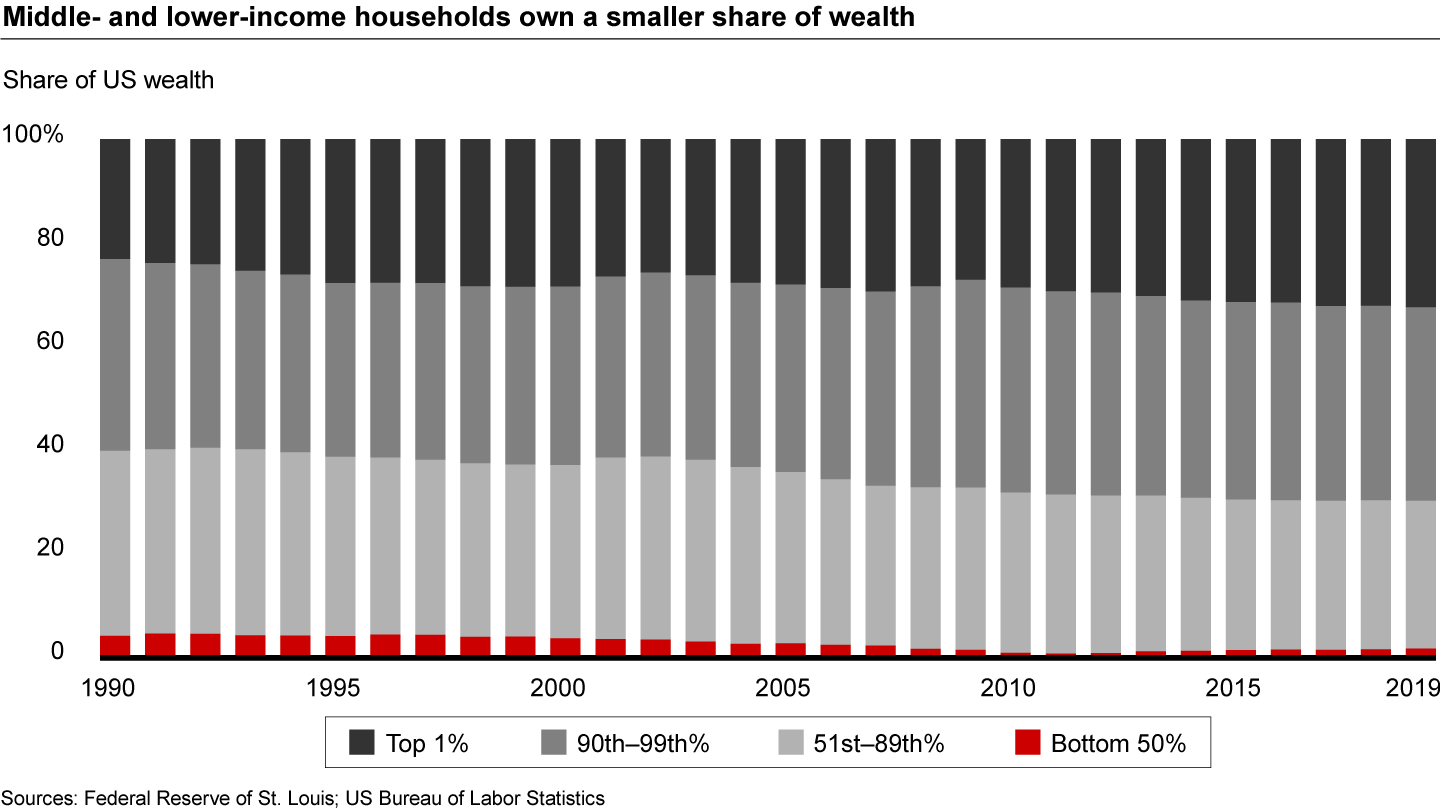
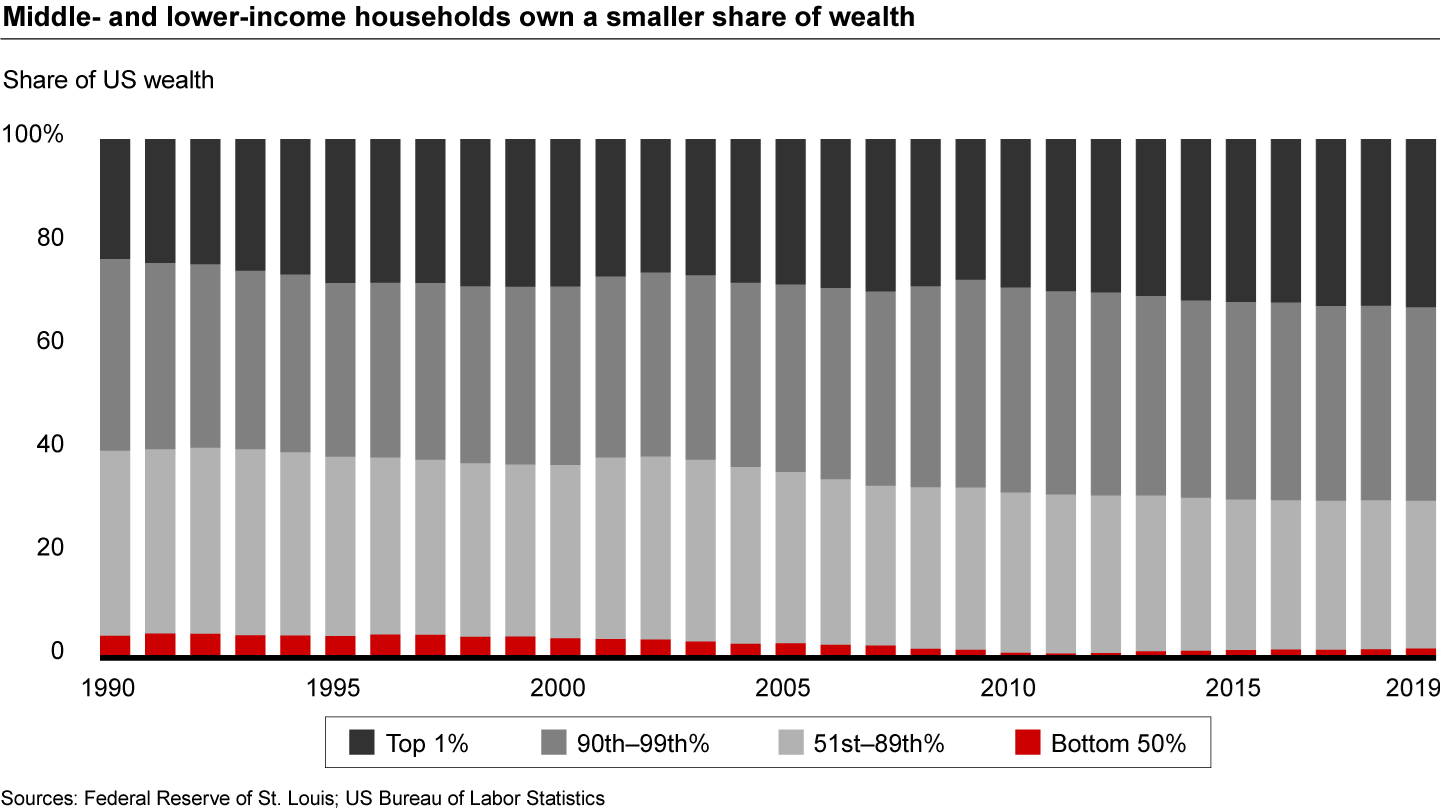
Covid-19 has further raised the appeal of automation, as companies were forced to move their operations remote within a matter of days, underscoring a greater need for automation to help maintain business continuity (see Figure 4).
Covid-19 is likely to accelerate automation across industries
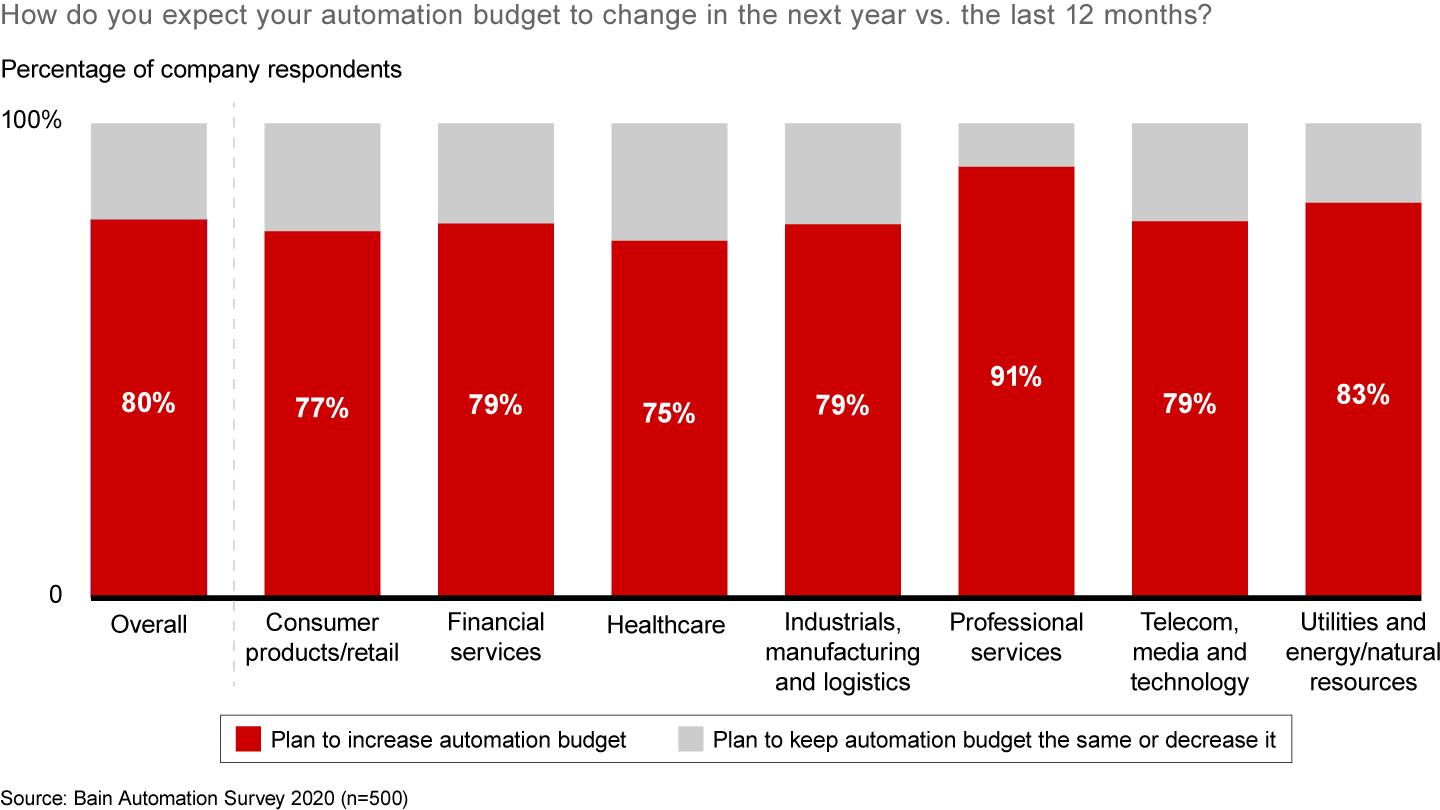
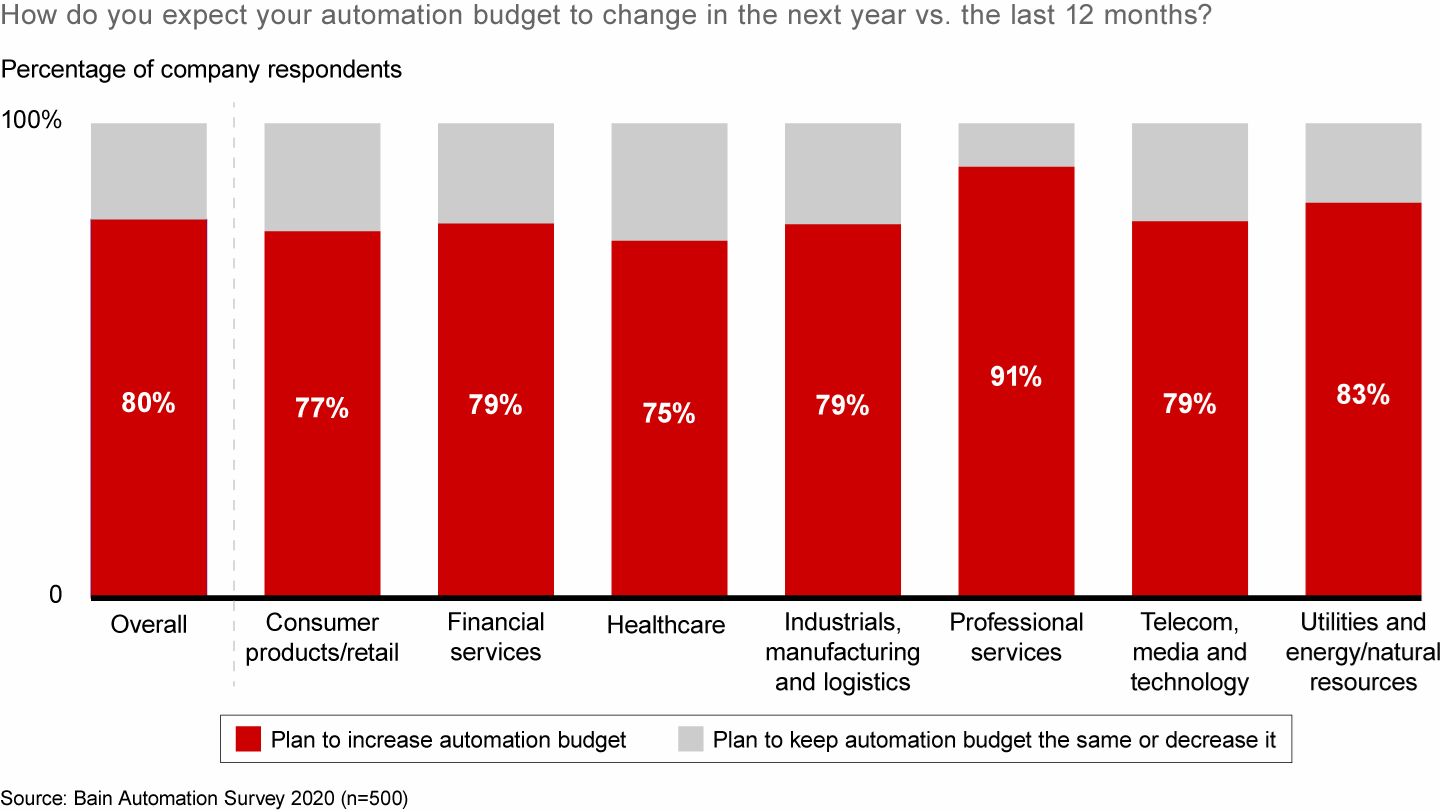
Middle-income markets are likely to erode. Although many people will continue to identify as “middle class,” pressure on the middle may shrink the three-tier household model to a primarily two-tier structure―in broad strokes, 20% upper income, 80% lower income. Think of this shift not in terms of precise percentage-point estimates, but rather as a framework to understand the scope of changes to households’ financial position. More middle- and lower-income Americans will live paycheck to paycheck and draw down already scant savings. High-income Americans, meanwhile, will accrue the benefits of automation.
New technologies might eventually create as many jobs globally as automation replaces (robot repair technician comes to mind). But that could take many years. And with so many workers displaced, more governments in more places are likely to expand their social safety nets or more aggressively redistribute wealth—though only after the disruption has occurred. So we do not expect either possibility to temper the degree of labor force disruption during the 2020s.
New value-price equations
Consumers whose financial situation becomes more precarious are having to adapt as well. Therefore, it is time for companies to reconsider their strategies for serving the expanding ranks of lower-income consumers. To start with the most obvious point, product pricing and service must be affordable for households on a constrained budget. However, lower prices do not mean engaging in a race to the bottom, but instead using tools such as bulk deals, discounts and dynamic pricing to set price structures.
Fast-food chain Dunkin’, for instance, launched a value menu across the US in 2018, called Dunkin’ Go2s, in addition to its Dunkin’ Deals promotions. The company aimed not only to make prices more attractive but also to ignite sales during slack times of day―for example, by offering a $2 medium coffee between 2 pm and 6 pm to spur midafternoon traffic. Besides providing deals to customers, the new menu resulted in a larger average check size of $8 to $9.
Verizon took a similar tack in wireless service when it funded Visible, a carrier that provides a low-cost unlimited option on the Verizon network. Visible rolled out Party Pay, an option where individuals are billed separately and only responsible for their portion of the plan. When the pandemic began, Verizon launched an ad blitz for Visible. It also ramped up marketing of new prepaid plans including lower prices, more data and rewards for customers who stick around. Although the US prepaid market has slipped for several quarters, Verizon is betting on an uptick in customers looking for low-cost options.
Verizon recently invested further in this strategy by buying TracFone, the largest reseller of wireless services in the US. The acquisition gives Verizon a bigger presence among value and low-income segments.
Pressure on household budgets has affected the grocery sector as well. Online, dollar, discount and club formats have gained market share in the US over the past five years, and Bain forecasts they will continue to do so through 2030. Their gains have and will come at the expense of traditional supermarkets and drug chains.
The ability to deliver lower-priced products profitably often requires changes to supply chain and franchise arrangements. Consider what happened when SC Johnson introduced a home-cleaning service to the slums of Nairobi, Kenya. As recounted in the Harvard Business Review by Erik Simanis and Duncan Duke, two business school professors who worked on the project, the marketing did not resonate with Nairobi residents. The company then tried a cleaning service for schools and other facilities, but recruiting and training workers was costly and time-consuming, and there were complications importing cleaning products in bulk and establishing franchise agreements with locals.
SC Johnson later applied these lessons when it began promoting insect-control products in rural Ghana. There, Simanis and Duke noted, SC Johnson created a direct-sales model, with coaches providing product demonstrations in homes and at community gathering places to build social support. The company bundled insect-control products with air fresheners and other items that consumers valued, encouraging sales. Buyers were also given refillable containers, which reduced packaging costs. Subscription pricing and loyalty rewards ensured that customers would continue to use the products and become more comfortable with the new insect-control routines.
Emotion and convenience matter, not just price
Like wealthy people, lower-income shoppers are motivated by priorities other than price. They, too, have become accustomed to a wide variety of choice, and they have emotional connections to certain brands. They may want to buy organic or local goods in some grocery categories. As part of their monetary trade-offs, they will be willing to trade up at times. Our recent survey of almost 2,000 US consumers finds that, although a majority of low-income households have cut back on spending during the pandemic, nearly 40% of this group still buy affordable luxuries they consider a special treat.
Indeed, many people in any social stratum tend to trade up to a premium product in categories they consider important, trading down to low-cost or private-label products in less meaningful categories. Increasingly left out in the cold are midpriced goods or services that fail to distinguish themselves through functional superiority or emotional resonance.
Walmart recognizes this dynamic, having identified segments that are particularly interested in its defining proposition of saving money: people living paycheck to paycheck, others scrimping on basics to pay for high-end purchases and well-off consumers who got that way in part through frugality. Based on observing shopping behavior in its China stores, Walmart learned that another segment that has slightly higher income―busy families―prizes convenience as much as price. Consequently, Walmart has been focusing in recent years on keeping the store experience clean, fast and friendly, improving measurable results like the length of the checkout line.
Convenience also figures prominently in Walmart Plus, a new subscription service for $98 per year. The service offers free same-day delivery on Walmart items, checkout through the company’s app, and a 5-cent-per-gallon discount on gas purchased at Walmart and Sam’s Club. The company’s first ad promoting the service emphasizes all the time it saves families.
Clearly, a number of segments exist within the huge swath of lower-income households. Identifying which segment to target with what proposition is essential to delivering “value for price” at still-tenable price points.
Flipkart, one of India’s largest e-commerce companies, segments customers according to how they perceive value, marketing to each segment differently. Discount seekers, for instance, look for deeply discounted products with additional cash back. Flipkart targets these customers through nonproduct offers. Price seekers care less about specific brands and more about shopping within their budget, so Flipkart works with lesser-known brands to create attractive propositions. Fee avoiders seek a simple shopping experience, and Flipkart caters to this group with transparent price and charge rules.
Questions for managers
Companies that target middle-income households will need to choose whether to move upmarket or downmarket soon, as the coronavirus has accelerated the collapse of the middle. Managers committed to making that shift can gain greater confidence in developing their strategy by answering a set of pointed questions:
- Do we fully understand the priorities of our core lower-income consumers and how their financial anxiety might affect their experience with us?
- Which segments within this customer base could demand changes in our value proposition, portfolio of products or marketing messages?
- How can we become essential to consumers who may increasingly consider our products discretionary?
- Is our cost to serve or deliver too high? What changes to our product formulation, supply chain or service infrastructure will reduce operating costs without detracting from the consumer’s experience?
- Are consumers shopping more for our products and services through online and mobile channels? Is our digital presence compelling, convenient and simple to use?
While low-income individuals may spend less than wealthy customers, their collective buying power will continue to grow. A lesser ability to pay does not always mean lower expectations. Retailers such as Aldi and Dollar General have thrived serving such consumers through innovations in distribution, supply chains, product formulas, packaging and digital service. At any level of the pyramid, understanding how consumers perceive value, and being able to deliver that value economically even in turbulent times, is essential for earning their loyalty.
Elements of Value® is a registered trademark of Bain & Company, Inc.

Coronavirus
The global Covid-19 pandemic has extracted a terrible human toll and spurred sweeping changes in the world economy. Across industries, executives have begun reassessing their strategies and repositioning their companies to thrive now and in the world beyond coronavirus.